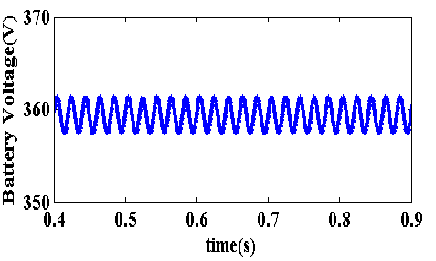ABSTRACT:
The scarcity of fossil fuel and the increased
pollution leads the use of Electric Vehicles (EV) and Hybrid Electric Vehicles
(HEV) instead of conventional Internal Combustion (IC) engine vehicles. An
Electric Vehicle requires an on-board charger (OBC) to charge the propulsion
battery. The objective of the project work is to design a multifunctional
on-board charger that can charge the propulsion battery when the Electric
Vehicle (EV) connected to the grid. In this case, the OBC plays an AC-DC
converter. The surplus energy of the propulsion battery can be supplied to the
grid, in this case, the OBC plays as an inverter. The auxiliary battery can be
charged via the propulsion battery when PEV is in driving stage. In this case,
the OBC plays like a low voltage DC-DC converter (LDC). An OBC is designed with
Boost PFC converter at the first stage to obtain unity power factor with low
Total Harmonic Distortion (THD) and a Bi-directional DC-DC converter to
regulate the charging voltage and current of the propulsion battery. The
battery is a Li-Ion battery with a nominal voltage of 360 V and can be charged
from depleted voltage of 320 V to a fully charged condition of 420 V. The
function of the second stage DC-DC converter is to charge the battery in a
Constant Current and Constant Voltage manner. While in driving condition of the
battery the OBC operates as an LDC to charge the Auxiliary battery of the
vehicle whose voltage is around 12 V. In LDC operation the Bi-Directional DC-DC
converter works in Vehicle to Grid (V2G) mode. A 1KW prototype of
multifunctional OBC is designed and simulated in MATLAB/Simulink. The power
factor obtained at full load is 0.999 with a THD of 3.65 %. The Battery is charged
in A CC mode from 320 V to 420 V with a constant battery current of 2.38 A and
the charging is switched into CV mode until the battery current falls below
0.24 A. An LDC is designed to charge a 12 V auxiliary battery with CV mode from
the high voltage propulsion battery.
KEYWORDS:
1.
Bi-directional DC-DC converter
2.
Boost PFC converter
3.
Electric vehicle
4.
Low voltage DC-DC converter
5.
Vehicle-to-grid.
SOFTWARE: MATLAB/SIMULINK
BLOCK DIAGRAM:
Fig
1 Block Diagram of Power distribution in EV
EXPECTED SIMULATION RESULTS:
(a)
(b)
(c)
(d)
(e)
(f)
(g)
(h)
Fig 2 Simulated Results of Charging operation of the
propulsion battery (a)Voltage and (b)Current in Beginning Point(c)voltage and
(d)current in Nominal Point (e)voltage and (f)current in Turning
Point(g)voltage and (h)current in End Point
Fig
3 DC link voltage and current during G2V operation (The current is multiplied
by 100 for batter visibility)
Fig 4 Voltage and Current of Auxiliary battery during charging (Current
is multiplied by 10 for better visibility)
CONCLUSION:
An On-Board
Electric Vehicle charger is designed for level 1 charging with a 230 V input
supply. Different stages of an OBC is stated and the challenges are listed. The
developments have been implemented to overcome key issues. A two stage charger
topology with active PFC converter at the front end followed by a
Bi-directional DC-DC converter is designed. The active PFC which is a Boost
converter type produces less than 5 % THD at full load. Moreover, the PFC
converter is applicable to wide variation in loads. The detailed design of the
power stage, as well as the controller, is discussed with the simulated
results.
A
second stage DC-DC converter is designed and simulated for the charging current
and voltage regulation. The converter performs very precisely by charging the
propulsion battery in CC/CV mode over a wide range of voltage. A V2G controller
has been developed for the DC-DC converter in order to supply power to the grid
from the propulsion battery. A new Low-Voltage DC-DC converter is proposed to
charge the Auxiliary battery via the propulsion battery utilizing the same OBC.
The battery voltage and current waveforms are presented and the performance of
the designed converter is verified.
REFERENCES:
[1] “No Title,” https://en.wikipedia.org/wiki/Electric_vehicle.
.
[2] S. S.
Williamson, Energy management strategies for electric and plug-in hybrid
electric vehicles. Springer, 2013.
[3] a. Emadi and
K. Rajashekara, “Power Electronics and Motor Drives in Electric, Hybrid
Electric, and Plug-In Hybrid Electric Vehicles,” IEEE Trans. Ind. Electron.,
vol. 55, no. 6, pp. 2237–2245, 2008.
[4] M. Yilmaz and
P. T. Krein, “Review of charging power levels and infrastructure for plug-in
electric and hybrid vehicles,” 2012 IEEE Int. Electr. Veh. Conf. IEVC 2012,
vol. 28, no. 5, pp. 2151–2169, 2012.
[5] H. Wang, S.
Dusmez, and A. Khaligh, “Design and analysis of a full-bridge LLC-based PEV
charger optimized for wide battery voltage range,” IEEE Trans. Veh. Technol.,
vol. 63, no. 4, pp. 1603–1613, 2014.










